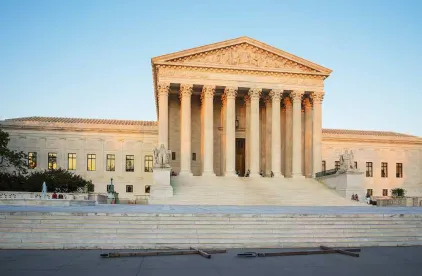In a per curiam majority decision issued on January 13, 2022, the United States Supreme Court stayed the implementation of the U.S. Occupational Safety and Health Administration’s (“OSHA”) Emergency Temporary Standard (“ETS”) that would have obligated employers with 100 or more U.S. employees to require proof of COVID-19 vaccination or weekly COVID-19 testing, plus imposed face covering and other mitigation strategies. Last month, the Sixth Circuit Court of Appeals lifted another federal appellate court’s earlier stay of the ETS, leaving employers scrambling just before the holidays to develop and disseminate policies and gather vaccination records before the effective date of the ETS (which was deferred until January 10, 2022). With the Supreme Court’s pronouncement, these efforts can be placed on hold for now.
Although recognizing that the Occupational Safety and Health Act (the “Act”) empowers OSHA to issue emergency standards before adhering to ordinarily-required notice-and-comment procedures prior to implementation, the Court noted that this extraordinary power may be exercised “only in the narrowest of circumstances,” where there is the risk of grave danger from exposure to substances or agents determined to be toxic or physically harmful and the emergency standard is necessary to protect employees from such danger. The Secretary of Labor/OSHA (the “Secretary”) had exercised this emergency power only nine times prior to the instant ETS, six of which times were challenged in court. Of these, only one instance of the exercise of authority was found to be lawful, and then only in part.
Against this backdrop, the Court found that OSHA’s COVID-19 ETS – “a blunt instrument” – was not likely to survive challenge and therefore should be stayed while the lower courts addressed the merits of the challengers’ arguments. First, the Court found that the Secretary lacked authority to impose the mandate, which the Court called “a significant encroachment into the lives – and health – of a vast number of employees.” The Court disagreed that the Act plainly authorized a broad public health measure, contrasting the proper exercise of OSHA’s authority to address workplace hazards and safety standards. Although the majority acknowledged that COVID-19 can be contracted in the workplace, “it is not an occupational hazard in most” and can be spread anywhere that people gather. The Court did not go so far as to say that OSHA can never regulate COVID-19 risks – it specifically recognized dangers that might be present in the workplace to medical researchers or those “working in particularly crowded or cramped environments,” but the ETS’s “indiscriminate approach” failed to draw distinctions based on industry or risk of exposure to COVID-19.
The Court refused to withhold interim relief and granted the stay over the Government’s argument that the ETS would save thousands of lives and prevent hundreds of thousands of hospitalizations in just the next six months. For its part, the parties petitioning for a stay argued that the ETS would force businesses to incur billions of dollars in unrecoverable compliance costs and risk hundreds of thousands of employees resigning rather than comply. Opining that it is not the Court’s “role to weigh such tradeoffs,” the Court left matters regarding sweeping public health measures to Congress, finding on the law before it that Congress had not delegated to OSHA the authority to issue such a sweeping mandate.
Justice Gorsuch, joined by Justices Alito and Thomas, authored a concurring opinion. Initially conceding that “the COVID-19 pandemic has posed challenges for every American,” Justice Gorsuch summed up his position by asking “Who decides?” That is, who decides how to respond to an unprecedented public health crisis? What followed this query was an lengthy discussion on states’ rights, with the concurring Justices observing that the “federal government’s powers…are not general but limited and divided,” and subject to the principle of separation of powers. On issues “of vast economic and political significance,” Congress must “speak clearly” if it intends to delegate its authority to regulate such matters to an administrative agency in the executive branch, such as OSHA. Finding no such unequivocal delegation of power to OSHA to regulate a pandemic through mandatory vaccination or testing, the concurring Justices were satisfied the ETS failed the “major questions” doctrine analysis.
Justice Breyer, with Justices Sotomayor and Kagan joining him, authored the dissent. The minority had little difficulty finding a workplace connectedness to a virus that transmits easily through person-to-person contact in confined indoor spaces, and which consequently “causes harm in nearly all workplace environments,” or in finding that OSHA acted consistently with the authority previously delegated to it by Congress. The dissenting Justices found unique workplace-related transmission risks of the virus, not only in densely-packed worksites like meatpacking industries, but in retail, healthcare, and office sites where employees had little control over their contact with coworkers and the public. The fact that transmission is possible outside of work did not diminish for the minority the occupational hazard presented by COVID-19; fire, electrical wiring risks, contaminated water, and poor air quality are all health and safety risks that can be found both inside and outside of work but nonetheless fell within the purview of OSHA. On this basis, the dissent found that OSHA not only was permitted to regulate, but compelled to take action, to mitigate the spread of COVID-19 at work.
The dissent was at times scathing, accusing the majority of “[a]cting outside of its competence and without legal basis,” “displac[ing] the judgments of the Government officials given the responsibility to respond to workplace health emergencies,” and “contravening clear legal principles and itself causing grave danger to the Nation’s workforce.” The dissent also criticized the majority’s repeated use of the phrase “vaccine mandate,” noting that doing so ignores the alternative for weekly testing, and of its giving short shrift to the number of work environments where compliance is relaxed or excused (e.g., exclusively outdoors work, work-from-home arrangements). But in the final calculus, only the majority’s opinion matters, and their opinion effectively nails shut the coffin on the ETS, at least in the short term.
That said, employers retain the right to implement mandatory vaccination, or “vax-or-test,” policies. They can and should implement mitigation strategies as part of their General Duty Clause obligations under the Act. And, as even the majority notes that it is for Congress and the States to determine appropriate measures to slow the spread, employers must remain vigilant for federal, state, and local requirements, some of which already mandate private sector vaccination.
As far as what happens from here, the case now will return to the Sixth Circuit for consideration of the merits of the parties’ arguments (what was before the Supreme Court was only whether the ETS should be stayed while the lower court considers the merits). It also will remain stayed if the losing party before the Sixth Circuit requests review of that court’s decision from the Supreme Court, and thereafter until either the Supreme Court declines to review the lower court’s decision or, if it accepts review, until it issues its own decision on the merits. Accordingly, it is unlikely that the ETS will go into effect any time in the foreseeable future.





 />i
/>i
